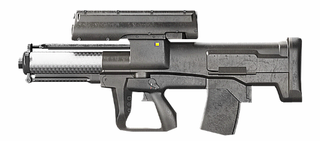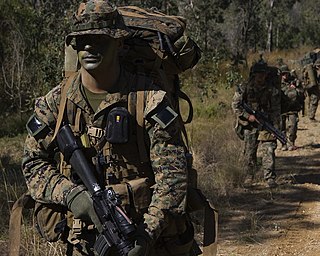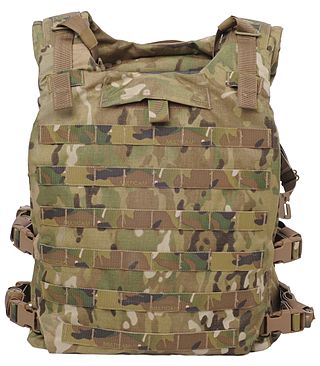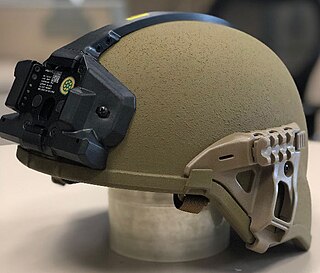Related Research Articles

The High Mobility Multipurpose Wheeled Vehicle is a family of light, four-wheel drive, military trucks and utility vehicles produced by AM General. It has largely supplanted the roles previously performed by the original jeep, and others such as the Vietnam War-era M151 jeep, the M561 "Gama Goat", their M718A1 and M792 ambulance versions, the Commercial Utility Cargo Vehicle, and other light trucks. Primarily used by the United States military, it is also used by numerous other countries and organizations and even in civilian adaptations. The Humvee saw widespread use in the Gulf War of 1991, where it navigated the desert terrain; this usage helped to inspire civilian Hummer versions. The vehicle's original unarmored design was later seen to be inadequate, and was found to be particularly vulnerable to improvised explosive devices in the Iraq War. The U.S. hastily up-armored select models and replaced front-line units with the MRAP. The U.S. military sought to replace the vehicle in front-line service under the Joint Light Tactical Vehicle (JLTV) program. In 2015 the Oshkosh L-ATV was selected for production.

A bulletproof vest, also known as a ballistic vest or a bullet-resistant vest, is an item of body armour that helps absorb the impact and reduce or stop penetration to the torso by firearm-fired projectiles and fragmentation from explosions. The vest may come in a soft form, as worn by many police officers, prison officers, security guards, and some private citizens, used to protect against stabbing attacks or light projectiles, or hard form, using metallic or para-aramid components. Soldiers and police tactical units wear hard armour, either in conjunction with soft armour or alone, to protect against rifle ammunition or fragmentation.
The Interceptor Multi-Threat Body Armor System (IBA) is a bullet-resistant body armor system that was used by the United States Armed Forces during the 2000s, with some limited usage into the mid-2010s. IBA and its design replaced the older standardized fragmentation protective Personnel Armor System for Ground Troops (PASGT) body armor system that was designed in the late 1970s and introduced in the early 1980s.

MOLLE is an acronym for Modular Lightweight Load-carrying Equipment. It is used to define the current generation of load-bearing equipment and backpacks used by a number of NATO armed forces, especially the British Army and the United States Army.

Personnel Armor System for Ground Troops is a combat helmet and ballistic vest that was used by the United States military from the early 1980s until the mid-2000s, when the helmet and vest were succeeded by the Lightweight Helmet (LWH), Modular Integrated Communications Helmet (MICH), and Interceptor Body Armor (IBA) respectively.

The XM25 Counter Defilade Target Engagement (CDTE) System, also known as the Punisher and Individual Semiautomatic Air Burst System was an airburst grenade launcher with programmable ammunition derived from the XM29 OICW. It was fielded to soldiers serving in the War in Afghanistan in 2010, after which malfunctions and 2013 program budget cuts delayed official entry into service, planned for early 2017. In early 2017, the contract with Orbital ATK was cancelled, calling the future of the entire program into question. The program was officially terminated on 24 July 2018.

The Small Arms Protective Insert (SAPI) is a ceramic ballistic plate used by the United States Armed Forces. It was first used in the Ranger Body Armor and Interceptor Body Armor, both are ballistic vests. It is now also used in the Improved Outer Tactical Vest as well as the Modular Tactical Vest, in addition to commercially available "plate carriers". The Kevlar Interceptor vest itself is designed to stop projectiles up to and including 9×19mm Parabellum submachine gun rounds, in addition to fragmentation. To protect against higher-velocity rifle rounds, SAPI plates are needed.

M320 Grenade Launcher Module (GLM) is the U.S. military's designation for a new single-shot 40 mm grenade launcher system to replace the M203 for the U.S. Army, while other services initially kept using the older M203. The M320 uses the same High-Low Propulsion System as the M203.

The Modular Integrated Communications Helmet (MICH) is a U.S. combat helmet and one of several used by the U.S. military. It was developed by the United States Army Soldier Systems Center to be the next generation of protective combat helmets for use by the U.S. Army.

The Improved Load Bearing Equipment (ILBE) is a United States Marine Corps program that had included individual load carriage equipment, individual hydration systems and individual water purification.

The Modular Tactical Vest is a ballistic vest originally adopted by the United States Marine Corps in 2006. The MTV was designed as a solution to shortcomings in the Interceptor Body Armor (IBA) and was selected after a rigorous proposal and examination process by the Marine Corps. The MTV provides better protection levels than the IBA, although it uses the same Small Arms Protective Insert (SAPI) plates. The MTV weighs 30 pounds (14 kg), three pounds more than the IBA, but is designed to more effectively distribute its weight throughout the wearer's torso.

Ranger Body Armor (RBA) is a US military-issue ballistic vest that was designed for, and used chiefly by, US Army 75th Ranger Regiment operators ("Rangers") in the 1990s and 2000s. The RBA system has since been replaced by other specialized body armor systems adopted by the United States Special Operations Command (USSOCOM).

The Improved Outer Tactical Vest (IOTV) is an enhanced version of, and a replacement for, the older Outer Tactical Vest (OTV) variant of the Interceptor Multi-Threat Body Armor System, as fielded by the United States Army. The IOTV is compatible with the Deltoid and Axillary Protector System (DAPS) components, ESAPI, Enhanced Side Ballistic Inserts (ESBI), as well as the OTV's groin protector. It has a flame-resistant standalone shirt, the Army Combat Shirt, designed specifically for use with the IOTV.

The Pouch Attachment Ladder System or PALS is a grid of webbing invented and patented by United States Army Natick Soldier Research, Development and Engineering Center used to attach smaller equipment onto load-bearing platforms, such as vests and backpacks. It was first used on MOLLE rucksacks, but is now found on a variety of tactical equipment, such as the U.S. Improved Outer Tactical Vest, Interceptor body armor, USMC Improved Load Bearing Equipment backpack and Modular Tactical Vest. It is used to attach items such as holsters, magazine pouches, radio pouches, knife sheathes, and other gear. A wide variety of pouches are commercially available, allowing soldiers to customize their kit. There is also a variety of attachment methods including the Alice Clip, the Natick snap, and soft, interwoven straps. The PALS system has begun to be adopted by other forces, such as the British Army, who use it on their Osprey body armor.

The Soldier Plate Carrier System (SPCS), known commercially as the KDH Magnum TAC-1, is a plate carrier developed for the U.S. Army which provides protection in accordance with if not greater than, the Improved Outer Tactical Vest. The SPCS is a lighter alternative to the IOTV, with increased mobility and comfort. The MSV, part of the US Army's SPS, is intended to replace all currently fielded body armor systems.

The Scalable Plate Carrier (SPC) is a plate carrier used by the United States Marine Corps as an alternative to the heavier Modular Tactical Vest (MTV).

The Infantry Branch is a branch of the United States Army first established in 1775.

The Modular Scalable Vest (MSV) is a bullet-resistant vest that has been introduced by the United States Armed Forces in 2018.

The Integrated Head Protection System (IHPS) is the United States Army's newest combat helmet, intended to eventually replace the Advanced Combat Helmet and Enhanced Combat Helmet.
References
- 1 2 3 4 Matthew Cox (6 April 2009). "Army stops shipment of lighter gear to field". Gannett Government Media Corporation. Retrieved 20 January 2011.
- 1 2 "Army Moves Forward With Plate Carrier Vest". 9 October 2009. Retrieved 20 January 2011.[ permanent dead link ]
- ↑ THOM SHANKER (17 April 2009). "Lightweight Armor Is Slow to Reach Troops". The New York Times Company. Retrieved 20 January 2011.
- ↑ "U.S. Army has selected the Blackhawk Serpa tactical holster for Modular Tactical Holster Program". January 14, 2014.
http://soldiersystems.net/2009/12/16/the-soldier-plate-carrier-system-a-journey/